
In today’s dynamic market, fashion businesses must adapt to evolving trends and technologies to remain competitive. The rise of digital commerce has revolutionized the fashion industry, providing unprecedented opportunities for growth and innovation. To thrive in this competitive landscape, it is crucial for fashion brands to implement effective E-Commerce Strategies for Fashion. This comprehensive guide explores the key elements of these strategies, offering valuable insights into how they can enhance your fashion business.
Understanding the E-Commerce Landscape in Fashion
The convergence of technology and fashion has transformed traditional retail models. E-commerce platforms now serve as critical touchpoints between brands and consumers, enabling businesses to reach global audiences with ease. As the digital marketplace continues to expand, understanding and leveraging effective e-commerce strategies becomes essential for sustaining growth and capturing market share.
The Impact of E-Commerce on the Fashion Industry
E-commerce has profoundly impacted the fashion industry, reshaping consumer behaviors and expectations. Online shopping provides consumers with a convenient, accessible way to explore and purchase fashion items. The proliferation of e-commerce platforms has led to an increase in competition, making it imperative for fashion businesses to develop robust strategies to stand out in the crowded marketplace.
Key Components of Successful E-Commerce Strategies
Effective E-Commerce Strategies for Fashion encompass several critical components. These include optimizing your online presence, leveraging data analytics, enhancing customer experience, and implementing targeted marketing tactics. Each of these elements plays a pivotal role in driving online sales and fostering brand loyalty.
1. Optimizing Your Online Presence
A well-designed e-commerce website is the cornerstone of a successful online fashion business. Your website should be visually appealing, user-friendly, and optimized for performance. Key aspects to consider include:
- Website Design and Usability: Ensure that your website’s design aligns with your brand identity and provides an intuitive shopping experience. Incorporate high-quality images, detailed product descriptions, and easy navigation to enhance user engagement.
- Mobile Optimization: With a growing number of consumers shopping on mobile devices, it is essential to optimize your website for mobile use. A responsive design that adapts to various screen sizes ensures a seamless shopping experience for all users.
- SEO Best Practices: Implement search engine optimization (SEO) techniques to improve your website’s visibility in search engine results. Use relevant keywords, optimize meta tags, and create high-quality content to attract organic traffic.
2. Leveraging Data Analytics
Data analytics provides valuable insights into customer behaviors, preferences, and trends. By leveraging data, fashion businesses can make informed decisions and tailor their strategies to meet customer needs. Key areas to focus on include:
- Customer Segmentation: Analyze customer data to segment your audience based on demographics, purchasing behavior, and preferences. This segmentation allows for targeted marketing efforts and personalized shopping experiences.
- Sales Performance Tracking: Monitor key performance indicators (KPIs) such as conversion rates, average order value, and customer lifetime value. Use this data to identify trends, assess the effectiveness of your strategies, and make necessary adjustments.
- Predictive Analytics: Utilize predictive analytics to forecast future trends and customer behaviors. By anticipating market changes, you can proactively adjust your inventory, marketing strategies, and product offerings.
3. Enhancing Customer Experience
Providing an exceptional customer experience is crucial for fostering loyalty and driving repeat business. Consider the following strategies to enhance the customer journey:
- Personalization: Personalize your shopping experience by offering tailored recommendations based on browsing history and purchase behavior. Implement features such as product recommendations, personalized emails, and loyalty programs to increase engagement.
- Customer Support: Offer responsive customer support through various channels, including live chat, email, and phone. Address customer inquiries and issues promptly to build trust and satisfaction.
- Streamlined Checkout Process: Simplify the checkout process to reduce cart abandonment rates. Implement features such as guest checkout, multiple payment options, and a user-friendly interface to enhance convenience.
4. Implementing Targeted Marketing Tactics
Effective marketing strategies are essential for driving traffic to your e-commerce site and increasing sales. Consider the following tactics to reach your target audience and boost brand visibility:
- Social Media Marketing: Leverage social media platforms to promote your brand and engage with customers. Create compelling content, run targeted ad campaigns, and use social media influencers to reach a wider audience.
- Email Marketing: Develop an email marketing strategy to nurture customer relationships and drive repeat business. Send personalized offers, product updates, and newsletters to keep your audience engaged.
- Content Marketing: Create valuable content that resonates with your target audience. This could include blog posts, videos, and lookbooks that showcase your products and provide fashion tips.
5. Utilizing Advanced Technology
Incorporating advanced technology can give your fashion business a competitive edge. Explore the following innovations to enhance your e-commerce strategy:
- Artificial Intelligence (AI): Implement AI-powered tools to improve customer service, personalize shopping experiences, and optimize inventory management. AI can also assist in analyzing customer data and predicting trends.
- Augmented Reality (AR): Use AR technology to enable virtual try-ons and interactive shopping experiences. This technology can help customers visualize how products will look on them, reducing the likelihood of returns.
- Blockchain: Explore blockchain technology for improving supply chain transparency and ensuring product authenticity. Blockchain can enhance trust and security in the fashion industry.
Conclusion
Implementing effective E-Commerce Strategies for Fashion is crucial for thriving in the competitive digital marketplace. By optimizing your online presence, leveraging data analytics, enhancing customer experience, and utilizing advanced technology, you can boost your fashion business and achieve long-term success. Embrace these strategies to stay ahead of the competition and build a strong, sustainable brand in the ever-evolving world of e-commerce.
For more insights and resources on e-commerce strategies, visit onlineqstore.com.







